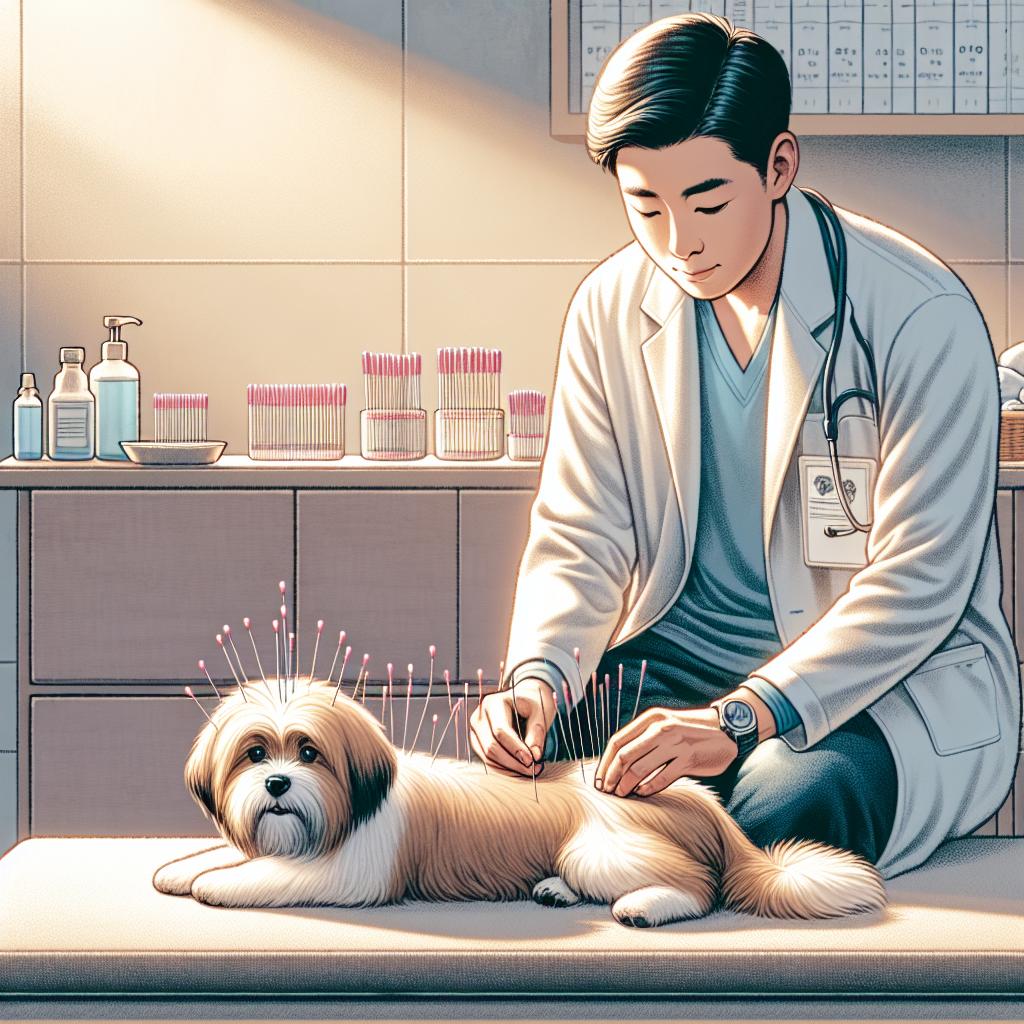
Key Takeaways
-
Acupuncture can be a valuable part of a rehabilitation plan, potentially helping dogs regain mobility faster post-surgery.
-
Supplements, such as glucosamine and omega-3 fatty acids, can support joint health and aid in the recovery process.
-
Hydrotherapy offers a low-impact exercise option that can improve muscle strength and joint mobility without straining the spine.
-
Creating a tailored rehabilitation plan with a professional can optimize recovery for dogs with disk disease.
-
Intervertebral Disk Disease (IVDD) is a common issue in small breed dogs that can cause pain, nerve damage, and paralysis.
The Trio of Healing: Acupuncture, Supplements, and Hydrotherapy
1. The Role of Acupuncture in Canine Disk Disease Recovery

Understanding Canine Acupuncture
Acupuncture, an ancient practice rooted in traditional Chinese medicine, involves the insertion of thin needles into specific points on the body to stimulate healing. In dogs, acupuncture points are found all over the body, and when these points are activated, they can promote pain relief, reduce inflammation, and enhance circulation.
Benefits of Acupuncture for Disk Rehabilitation
For small breed dogs suffering from IVDD, acupuncture can be a game-changer. It’s been shown that incorporating acupuncture into post-surgery treatment plans can lead to quicker recovery times. Dogs that receive acupuncture may regain the ability to walk sooner than those who don’t, and here’s why:
-
Pain Management: Acupuncture releases endorphins, the body’s natural painkillers, reducing the need for pharmaceuticals.
-
Reduced Inflammation: By promoting blood flow, acupuncture can help decrease swelling around the injured disks.
-
Enhanced Nerve Function: Stimulating nerves through acupuncture can improve communication between the brain and the rest of the body, aiding in motor function recovery.
Finding a Qualified Veterinary Acupuncturist
Not all heroes wear capes, but the best ones do come with the right credentials. When seeking acupuncture for your dog, it’s crucial to find a certified veterinary acupuncturist. These professionals have undergone extensive training in animal acupuncture, ensuring they understand the unique anatomy and needs of your pet. A good place to start is by asking your primary vet for a referral or searching for practitioners certified by the American Academy of Veterinary Acupuncture (AAVA).
2. Top Supplements for Joint and Disk Health

Supplements can be powerful allies in the fight against IVDD. They can support the body’s natural healing processes, provide essential nutrients for joint health, and offer anti-inflammatory benefits. However, not all supplements are created equal, and it’s important to choose wisely for your small breed dog.
Glucosamine and chondroitin are the dynamic duo for joint support, helping to maintain cartilage health and joint fluidity. Omega-3 fatty acids, found in fish oil, can combat inflammation and promote a healthy immune response. Another key player is methylsulfonylmethane (MSM), which can help alleviate pain and inflammation.
But it’s not just about picking the right supplements; it’s about providing the correct dosage for your dog’s size and needs. Always consult with your vet before starting any new supplement regimen to ensure it’s safe and appropriate for your pet’s specific condition.
Example: A small breed dog like a Yorkshire Terrier may benefit from a daily regimen of 250mg of glucosamine, 200mg of chondroitin, and a fish oil capsule containing at least 200mg of EPA/DHA, as per veterinary recommendation.
How to Safely Introduce Supplements
Introducing supplements to your dog’s diet should be done with care. Start with a small dose and gradually increase to the recommended amount over a few weeks. This will help your dog’s system adjust and reduce the risk of any gastrointestinal upset.
Additionally, keep a close eye on your dog for any signs of adverse reactions, such as changes in appetite, behavior, or bowel movements. If you notice anything unusual, contact your vet immediately.
3. Making Waves with Hydrotherapy

-
Hydrotherapy can improve muscle strength and endurance without putting stress on the spine.
-
Water resistance during hydrotherapy sessions provides a safe way to exercise and build up core muscles.
-
Warm water can help relax muscles and increase circulation, aiding the healing process.
-
Hydrotherapy is particularly beneficial for dogs that may be overweight or unable to bear weight on their limbs.
Now, let’s take a closer look at how hydrotherapy works and why it’s such a beneficial part of rehabilitation for small breed dogs with disk disease.
Hydrotherapy uses the properties of water — buoyancy, resistance, and hydrostatic pressure — to create an ideal environment for rehabilitation exercises. In the water, your dog’s body weight is supported, which means there’s less strain on the joints and spine. This allows for movement and exercise that would be too painful or risky on land.
Moreover, the resistance of water provides a gentle but effective way to strengthen muscles. And let’s not forget the psychological benefits — many dogs enjoy the sensation of being in water, which can be a real morale booster during the recovery process.
Intro to Hydrotherapy for Dogs
Hydrotherapy for dogs typically takes place in a specially designed pool or an underwater treadmill. These facilities are designed to cater to the needs of dogs of all sizes, including small breeds. The water is usually heated to a comfortable temperature to relax muscles and encourage blood flow.

How Hydrotherapy Speeds Up Recovery
Regular hydrotherapy sessions can significantly speed up your dog’s recovery from disk disease. The gentle exercise helps to maintain muscle mass and prevent atrophy, while also improving range of motion and flexibility. Additionally, the water’s warmth and pressure can have a soothing effect on sore or inflamed tissues.
Where to Find Canine Hydrotherapy Services
Finding a reputable hydrotherapy service for your dog involves some research. Start by asking your vet for recommendations, as they may know of local facilities with experience in treating small breed dogs. You can also search for certified canine rehabilitation practitioners (CCRP) or facilities accredited by organizations such as the American Association of Rehabilitation Veterinarians (AARV).
When evaluating a hydrotherapy service, consider factors such as the cleanliness of the facility, the qualifications of the staff, and the availability of equipment suited for small breeds. It’s also a good idea to ask for a tour and observe a therapy session to see how the dogs are handled and whether they seem comfortable and safe.
4. Creating a Rehab Plan That Works for Your Dog
Every dog is unique, and their rehabilitation plan should be too. To create an effective plan for your small breed dog, you’ll need to consider their specific IVDD diagnosis, overall health, temperament, and response to treatment. Collaboration with your veterinarian and a certified rehabilitation therapist is key to designing a program that will address all aspects of your dog’s recovery.
For example, Bella, a miniature dachshund, had a customized rehab plan that included weekly acupuncture sessions, daily glucosamine supplements, and bi-weekly hydrotherapy. This combination helped her regain full mobility within three months post-surgery.
As your dog progresses through their rehabilitation, it’s important to monitor their response to each treatment. If they’re responding well to acupuncture but not enjoying hydrotherapy, adjustments can be made. The goal is always to promote healing while ensuring your dog’s comfort and well-being.
Lastly, remember that patience is key. Recovery from disk disease can be a slow process, but with the right approach, you can maximize your dog’s chances of a successful outcome. Celebrate the small victories along the way and maintain a positive attitude — your support is an integral part of your dog’s healing journey.
Integrating Acupuncture, Supplements, and Hydrotherapy
Creating a harmonious blend of acupuncture, supplements, and hydrotherapy is like orchestrating a symphony; each element plays a critical role in the overall performance. When these three modalities come together, they can support each other in ways that amplify your dog’s healing process. It’s not just about adding treatments together; it’s about finding the right rhythm and balance that suits your dog’s individual needs.
For instance, acupuncture might be scheduled on days when there’s no hydrotherapy, to ensure your dog doesn’t become overwhelmed. Supplements should be a daily constant, providing ongoing support for joint health. By weaving these therapies into a cohesive plan, you create a robust framework for recovery that addresses pain, mobility, and overall well-being.
Tracking Progress and Adjusting the Plan
Monitoring your dog’s progress is essential for adapting the rehab plan as needed. Keep a detailed log of your dog’s activities, their response to treatments, and any changes in their condition. This log will be invaluable when consulting with your vet or rehab therapist to determine what’s working and what might need tweaking. Remember, rehabilitation is not a linear process; be prepared to adjust the plan as your dog heals and regains strength.
Frequently Asked Questions
When embarking on a rehabilitation journey with your small breed dog, questions are bound to arise. Below are answers to some of the most common queries that pet owners have regarding disk disease rehabilitation.
How long does it take to see results from acupuncture in dogs?
Results from acupuncture can vary depending on the severity of your dog’s condition and their individual response to treatment. Some dogs may show signs of improvement, such as reduced pain or increased mobility, within the first few sessions. However, for others, it may take several weeks to notice a significant change. It’s important to maintain consistent treatment and follow the guidance of your veterinary acupuncturist.
Are there any risks associated with giving a dog supplements?
While supplements are generally safe, there can be risks if not used correctly. Over-supplementation, for instance, can lead to vitamin toxicity or adverse interactions with other medications. Always consult with your vet before starting any new supplements to ensure they’re appropriate for your dog’s health status and to determine the correct dosage.
Can hydrotherapy be done at home?
Hydrotherapy at home is possible but should be approached with caution. If you’re considering at-home treatments, such as using your bathtub for gentle exercises, consult with a rehabilitation specialist first. They can provide guidance on safe practices and exercises. For more advanced hydrotherapy, such as underwater treadmills, professional facilities are recommended due to the specialized equipment and expertise required.
What signs indicate my dog is recovering well?
Signs of a good recovery include an increase in mobility, a decrease in pain, improved appetite, and a return to normal behavior and energy levels. You might also notice your dog is more willing to engage in play and is generally happier. Keep in mind that recovery can be gradual, so these signs may appear slowly over time.
What if my small breed dog shows no improvement?
If your dog isn’t showing signs of improvement, don’t lose heart. Consult with your vet to reassess your dog’s condition and the current rehab plan. It may be necessary to adjust the treatments or explore other options. In some cases, further diagnostics or even a referral to a specialist may be required. The key is to stay proactive and to keep the lines of communication open with your veterinary team.
In conclusion, when your small breed dog is faced with the challenge of disk disease, a comprehensive approach to rehabilitation can make all the difference. Acupuncture, supplements, and hydrotherapy each offer unique benefits that can help your dog on their road to recovery. With patience, dedication, and the right combination of treatments, you can support your dog in regaining their zest for life. Remember, each step forward is a victory, and with your love and care, your dog has the best teammate they could ask for in this journey back to health.
Small breed dogs, such as Shih Tzus and Dachshunds, are particularly prone to disk diseases like Intervertebral Disk Disease (IVDD). These conditions can cause significant pain and mobility issues. Fortunately, there are several treatment options available to help manage symptoms and improve quality of life. Acupuncture, for instance, has been shown to provide relief for some dogs. Dietary supplements that support joint health can also be beneficial. Additionally, hydrotherapy is often recommended for its low-impact exercise benefits, which can help strengthen muscles without putting too much strain on the spine.






